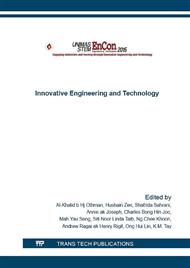[1]
Bentur, A., and Mindess, S. 2006. Fibre reinforced cementitious composites. 2nd ed. London: Taylor & Francis.
DOI: 10.1201/9781482267747
Google Scholar
[2]
Li, Z. G., Wang, L. J., and Wang, X. F. 2007. Cement composites reinforced with surface modified coir fibres. Journal Composite Material. 41: 1445-1447.
Google Scholar
[3]
Kong, X.M., Wu, C.C., Zhang, Y.R. and Li, J. 2014. Polymer-modified mortar with a gradient with a gradient polymer distribution: preparation, permeability, and mechanical behaviour. Construction and Building Materials. 38: 195-203.
DOI: 10.1016/j.conbuildmat.2012.07.080
Google Scholar
[4]
Jenni, A., Zurbriggen, R., Holzer, L. and Herwegh, M. 2006. Changes in microstructures and physical properties of polymer-modified mortars during wet storage. Cement and Concrete Research. 36(1): 79-90.
DOI: 10.1016/j.cemconres.2005.06.001
Google Scholar
[5]
Yang, Z., Shi, X., Creighton, A. and Peterson, M. 2008. Effect of styrene-butadiene rubber latex on the chloride permeability and microstructure of Portland cement mortar. Construction and Building Materials. 23(6): 2283-2290.
DOI: 10.1016/j.conbuildmat.2008.11.011
Google Scholar
[6]
Mirza, J., Mirza, M. and Lapointe, R. 2002. Laboratory and field performance of polymer-modified cement-based repair mortars in cold climates. Construction and Building Materials. 16(6): 365-74.
DOI: 10.1016/s0950-0618(02)00027-2
Google Scholar
[7]
Wang, R., and Wang, P. 2010. Function of styrene-acrylic ester copolymer latex in cement mortar. Material Structure. 43(4): 443-451.
DOI: 10.1617/s11527-009-9501-3
Google Scholar
[8]
Al-Zahrani, M., Maslehuddin, M., Al-Dulaijan, S. and Ibrahim, M. 2003. Mechanical properties and durability characteristics of polymer and cement-based repair materials. Cement Concrete Composites. 25(4-5): 527-537.
DOI: 10.1016/s0958-9465(02)00092-6
Google Scholar
[9]
Afridi, M., Ohamat, Y., Zafar Iqbal, M. and Demuras, K. 2003. Behaviour of Ca(OH)2 in polymer modified mortars. The international Journal of Cement Composites and Lightweight Concrete: 235-244.
DOI: 10.1016/0262-5075(89)90104-8
Google Scholar
[10]
Jansen, D., Goetz-Neunhoeffer, F., Neubauer, J., Haerzschel, R. and Hergeth, W. -D. 2013. Effect of polymers on cement hydration: A case study using substituted PDADMA. (Elsevier, Ed. ) Cement and Concrete Composites. 35: 71-77.
DOI: 10.1016/j.cemconcomp.2012.08.022
Google Scholar
[11]
Chandra, S. and Flodin, P. 1987. Interactions of polymer and organic admixtures on Portland cement Hydration. Cement and Concrete Research. 17: 875-90.
DOI: 10.1016/0008-8846(87)90076-7
Google Scholar
[12]
Jansen, D., Goetz-Neunhoeffer, F., Stabler, C. and Neubauer, J. 2001. A remastered external standard method applied to the quantiification of early OPC hydration. Cement and Concrete Research. 41: 602-608.
DOI: 10.1016/j.cemconres.2011.03.004
Google Scholar
[13]
Plank, J. and Gretz, M. 2008. Study on the interaction between anionic and cationic latex particles and Portland cement. Colloids and Surfaces A: Physicochem. Colloids Surf. 330: 227-33.
DOI: 10.1016/j.colsurfa.2008.08.005
Google Scholar
[14]
Larbi, J. and Bijen, J. 1990. Interaction of polymers with Portland cement during hydration - a study of the chemistry of the pore solution of polymer-modified cement systems. Cement and Concrete Research. 20: 139-47.
DOI: 10.1016/0008-8846(90)90124-g
Google Scholar
[15]
Antonovič, V., Stonys, R., Pundienė, I. et al. 2009. Investigation of formation of structure of complex binder. Materials Science (Medžiagotyra). 15(4): 343-348.
Google Scholar
[16]
Zawrah, M. F. and Khalil, N. M. 2007. Synthesis and characterization of calcium aluminate nanoceramics for new applications. Ceramics International. 33: 1419-1425.
DOI: 10.1016/j.ceramint.2006.04.022
Google Scholar
[17]
Almeida, A. E. F. and Sichieri, E. P. 2006. Mineralogical study of polymer modified mortar with silica fume. Construction and Building Materials. 20(10): 882-887.
DOI: 10.1016/j.conbuildmat.2005.06.029
Google Scholar
[18]
Soufiane, B., Mouli, M., Taibi, H. and Belbachir, M. 2012. Mineralogical study of polymer-mortar composites with PET polymer by means of spectroscopic analyses. Materials Sciences and Applications: 139-150.
DOI: 10.4236/msa.2012.33022
Google Scholar
[19]
Wang, J., Zhang, S., Yu, H., Kong, X., Wang, X. and Gu, Z. 2005. Study of cement mortars modified by emulsiofier-free latexes. (Elsevier, Ed. ) Cement and Concrete Composites. 27: 920-925.
DOI: 10.1016/j.cemconcomp.2005.05.005
Google Scholar
[20]
Xu, F., Mingkai, Z., Jianping, C. and Shaoqin, R. 2014. Mechanical performance evaluation of polyester fiber and SBR latex compound-modified cement concrete road overlay material. (Elsevier, Ed. ) Construction and Building Materials. 63: 142-149.
DOI: 10.1016/j.conbuildmat.2014.04.054
Google Scholar


